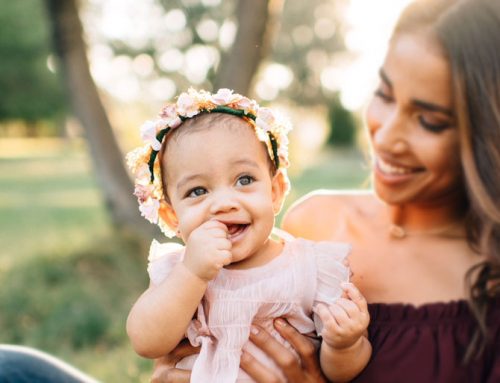by Narissa Ventress, M.A., CCC-SLP
All parents know the joys (and challenges) of encouraging speech in a baby or young child. One moment she’s reacting intently to your “words of wonder” and the next is something like talking to the sky. All of this –and oh, let’s not forget the endless variety of development of mind, body, and temperament– makes for quite a demand on even the most motivated parent looking to “make a connection” at every turn. So, we (naturally) turn to what works and try to update our understanding when the pros, science, or our own experience reveals something interesting.
So what’s interesting? Well, studies show that infants can learn the name of objects that interest them much easier than the words their communicative partner thinks is important. Not extremely surprising, especially since speech usually depends on what we want to say. However, in a more recent study, babies learned 2 new words in 5 minutes after only being presented with the object while hearing the word 5 times. The babies in the study paired a new word with the object they were most interested in, irrespective of what object the speaker was referring to. In other words, that baby assumed his communicative partner was talking about the object they liked best (i.e. paid the most attention to).
While it doesn’t take rocket science to learn and experiment with a new technique to fit a situation, try laying out a simple foundation for encouraging speech with your child that serves nearly all meaningful encounters.
1Observe (Actively)
To actively observe, track what your baby is looking at by putting toys out at his eye level and watching where he looks, reaches, or moves his body to. In the speech world we call this “listening with your eyes.” Not only is your child more engaged when presented with items he is interested in, you’re both paying Joint Attention, which has been shown to drive learning and language development.
- Joint attention: is the act of using gestures and gaze to share attention (usually between an adult and a baby/child) about interesting objects or events; moreover, it plays a critical role in both language and social development.
You can show him 15 different cause-and-effect toys, but if he only shows interest when you relentlessly blow bubbles, then continue to blow bubbles (while injecting rich verbal dialogue during the interaction). Talk about the bubble activity using a variety of words (e.g., pop, up, blow, big bubble, small bubble, lots of bubbles, uh oh try again, do you want more, etc.). If your children’s interests change, then observe what they go to next and follow their lead.
2Respond (Consistently)
How do we respond appropriately, and what does that even mean? Adults (I’m guilty here too) can tend to get caught in a pattern of asking too many questions (i.e., what color is this? is this a square?). These interactions can sometimes put a STOP to the conversation, especially when your child isn’t engaged…yet, or you’ve simply run out of ideas. Instead of asking questions, here we want to become “the narrator”. This might mean to:
- Imitate your child’s words or actions (e.g., Child (babbling): “dadada” , Parent: “Dada went to the store. You miss dada?”);
- Comment on her words or actions (e.g., Child: “Duckie”, Parent: “I see a duckie too, the duckie says “quack” and swims in the water”);
- Expand on her words or actions (e.g., Child (Dancing to music), Parent: “You must like the music, let’s turn it up!”);
- Ask questions about her words or actions (e.g., Child: “Airplane?” Parent: “I hear the airplane too! Where does a plane fly?”); or,
- Answer her questions (e.g., Child: “Where my spoon?” Parent: “Your spoon is in the dishwasher, we cleaned it”).
Babies learn language by hearing words when they are interested, so TALK, TALK, and TALK, remembering to stay within your child’s language abilities while gently encouraging advanced language (i.e. If your child is using one-to-two words to communicate, respond using three-to-four words).
3Be Present (Seriously)
Seems intuitive, right? Well, just as the job of good parenting can be about as complex and nuanced as anything, being merely “in the presence of” compared to being seriously present for your child can yield significantly different results in speech and language development. So, to be present, designate times to be with just your child. Put away your phone, turn off the TV, and get down to his eye level. Block out 15-30 minutes for your little one (hopefully a few times a day) and make it his or her time, either planned or in the moment. Although some days might feel just too busy (this happens so don’t feel guilty), your little ones will benefit from simply having you on the floor next to them while you catch up on emails, develop that report, or finish that last bit of [insert obligation]. Now that’s multitasking 😉
For more info, see:
Verbal Expectations: Birth to 3 Months
Verbal Expectations: 4-6 Months
See asha.org for additional resources.





